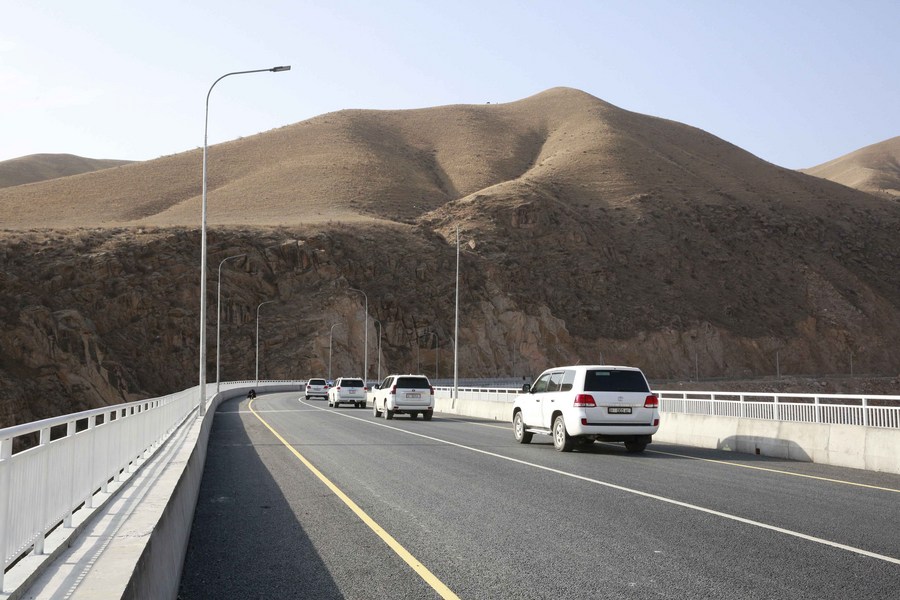
This photo taken on May 15, 2023 shows a view of a scenic moat area along the ancient city wall in Xi'an, northwest China's Shaanxi Province. (Xinhua/Zhang Bowen)
BEIJING, May 17 (Xinhua) -- China has upgraded its relations with the five Central Asian countries, namely Kazakhstan, Kyrgyzstan, Tajikistan, Turkmenistan and Uzbekistan, since the establishment of diplomatic ties 31 years ago.
China-Central Asia economic cooperation, joint project development, and people-to-people exchanges under the framework of the Belt and Road Initiative (BRI) have achieved tangible results over the past years.
The China-Central Asia Summit will be held in Xi'an, northwest China's Shaanxi Province from Thursday to Friday. It is of milestone significance in the development of relations between China and Central Asian countries. Officials and experts expect the summit to open a new chapter in China-Central Asia cooperation.
-- Extensive economic, trade cooperation
Economic and trade cooperation is a highlight of China-Central Asia collaboration amid extensive achievements being made in various fields, said Ding Xiaoxing, director of the Institute of Eurasian Studies of China Institute of Contemporary International Relations.
China's trade with the five Central Asian countries increased 100-odd times since the establishment of diplomatic ties in 1992. The value of two-way trade hit a record high of 70.2 billion U.S. dollars in 2022 and recorded a 22 percent year-on-year expansion in the first quarter of this year, according to Shu Jueting, spokesperson for the Ministry of Commerce (MOC).
China's super-large market, complete industrial system and advanced technologies are very attractive to Central Asian countries, said Ding, adding the principle of equality and mutual benefit has rendered the sustained and stable growth in cooperation between the two sides.
The trade structure has also improved over the years. China's imports of agricultural, energy and mineral products from these countries in 2022 jumped over 50 percent from a year ago, while its exports of mechanical and electronic products to them increased by 42 percent, according to Shu.
The MOC spokesperson also noted that as of the end of March, China's direct investment stock in the five countries stood at over 15 billion U.S. dollars.
China-Central Asia economic cooperation is extending to more areas and will cover new forms of business like e-commerce and digital economy in the future, said Su Chang, a researcher with the Institute of Russian, Eastern European and Central Asian Studies at the Chinese Academy of Social Sciences.
The China-Central Asia Summit is seen as the latest landmark in China-Central Asia cooperation.
China will take the summit as an opportunity to join hands with the five Central Asian countries and push economic and trade cooperation to a new level, said Shu.
-- Beneficial projects under BRI
Over the past decade, Central Asian countries have become pioneers in promoting the Belt and Road Initiative (BRI), working with China on a number of projects resulting in common development.
For example, many Chinese-participated infrastructure construction projects have been successfully implemented in Central Asia, bringing benefits to local people and promoting good-neighborly relations.
In February 2016, China Railway Tunnel Group completed building the Qamchiq Tunnel on the Angren-Pap railway line in Uzbekistan, putting an end to the history when local people had to go through foreign territories as they traveled between the capital city of Tashkent to the eastern city of Fergana.
The 19.2 kilometer-long tunnel, the longest in Central Asia, goes through the Qurama Mountains to cut the time of travel by two thirds and the costs of regional transportation, thus helping boost Uzbekistan's trade and economy.

Photo taken on Nov. 10, 2021 shows vehicles running on a bridge completed during the second phase of a new North-South highway project in Kazarman of Jalalabad Region, Kyrgyzstan. (Photo by Roman/Xinhua)
On November 10, 2021, China Road and Bridge Corporation finished the construction of the second phase of the new North-South highway project in the south of Kyrgyzstan. The 433 kilometer-long highway, once operational, will become the main transport artery connecting Kyrgyzstan's north and south areas and an important international transport channel in Central Asia.
On December 28, 2022, 30 sets of generators with a total capacity of 150 megawatts of the first phase of a Chinese-built wind power project in the Akmola Region of north Kazakhstan was connected to the grid and began generating power, bringing clean energy to thousands of local households.
With the second phase scheduled to start operation in September of this year, the wind power project invested and developed by China's State Power Investment Corporation Limited is expected to provide about 600 million kilowatt hours of clean electricity to local people.
Improved infrastructure makes people's life better and promotes trade facilitation, said Su. He also stated that strengthening cooperation on infrastructure projects will unleash the potential for interconnection between China and Central Asian countries in more areas such as the Internet of Things.
-- Frequent cultural exchanges
As China deepens cooperation with Central Asian countries, cultural exchanges between the two sides continue increasing, said Su.
From 2014 to 2019, China and Uzbekistan jointly carried out a restoration project of an ancient Uzbek city of Khiva, which, with a history of over 2500 years, is able to fascinate the world with its profound culture.
In January of 2022, China announced to provide 1,200 government scholarships to students from the five Central Asian countries in the next five years, and proposed to bring the number of sister cities with the five countries to 100 pairs in the next five to ten years.
In February of last year, China and Uzbekistan signed a memorandum on translating and publishing classic works from the two countries. According to the memorandum, at least 50 classic works from China and Uzbekistan would be translated and published within the next five years, in a bid to enhance mutual understanding and friendship through the provision of more fine translated works.
In last November, a Luban Workshop was officially put into operation in Tajikistan, providing vocational training to young students seeking skilled employment.
As good neighbors, friends, partners, and brothers, China and Central Asian countries will prioritize cultural exchanges in future cooperation, Ding said. (Edited by Su Dan with Xinhua Silk Road, sudan@xinhua.org)




 A single purchase
A single purchase









